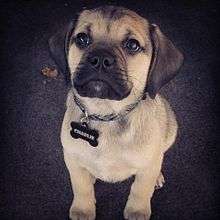Puggle
 A picture of a Puggle. | |
| Foundation stock | Beagle, Pug |
|---|---|
| Variety status | Not recognized as a standardized breed by any major kennel club. |
| Domestic dog (Canis lupus familiaris) | |

Puggle is the name for a crossbreed dog with a beagle parent and a pug parent. The name puggle is a portmanteau, following a naming trend in "designer dog"[1] crossbreeding.
"Puggle" dogs can also be named Bug, Buggle, or a Peagle. But, they are most commonly known as a Puggle. This dog is sometimes classified as a Designer Dog.
History
Wisconsin breeder Wallace Havens bred the first puggle in the 1980s.[2] Havens coined the name puggle and was the first to register the crossbreed with the American Canine Hybrid Club, an organization that tracks crossbred dogs. Although Havens was the first to officially breed a puggle, the history of puggles dates back to the 1980s when U.S. breeders experimented with creating new dogs.[3] By 2000, puggles were being sold commercially to pet owners wanting to own a different, distinctive dog.
No major kennel clubs or other breed registries – such as American Kennel Club, United Kennel Club, and Canadian Kennel Club – recognize puggles as a dog breed. Puggles are an intentionally crossbred form of mongrel, and have sometimes been called a designer dog.[4]
Description
Puggles are great family dogs, they love to be around kids and are very friendly. They have characteristics of beagles, meaning they love to sniff for things. Puggles grow to a mature weight of 15 to 40 pounds, with a shoulder height of 8 to 15 inches.[5] They can be a variety of colors and patterns depending on the characteristics inherited from the parent breeds. The most common colors are tan, fawn, or black. Mixed colors are not commonly found. They may have a short nose like the pug, or a longer snout like a beagle. The temperament of puggles generally combines the active and inquisitive nature of the Beagle with the companionable nature of the Pug. These psychographic traits make it a companion breed with lower required exercise needs.[6]
Although puggles are great family dogs, they are not great apartment dogs since Pugs like to bark and Beagles are known for howling. Puggles tend to do both.
Health
Both Beagles and Pugs can have cherry eye, but more importantly, they can inherit progressive retinal atrophy so reputable breeders will DNA test for this condition.[6] Puggles can also inherit hip dysplasia from one or both of their parents. Some puggles can have food and environmental allergies. If the allergies are serious enough, a special diet, prescription medication or steroid shots may be needed.
Puggles who have longer snouts like the Beagle parent are at a reduced risk of respiratory problems, however, puggles can occasionally have the respiratory ailments commonly found in Pugs (a breed known for being brachycephalic).[6] One nonthreatening respiratory ailment that puggles sometimes have is reverse sneezing (also called backwards sneezing or inspirational paroxysmal respiration).
References
| Wikimedia Commons has media related to Puggle. |
- ↑ "Dogs 101 - Designer Dogs". 30 May 2012.
- ↑ "The Modern Kennel Conundrum". The New York Times. p. 1. Retrieved 5 June 2013.
- ↑ The Modern Kennel Conundrum, The New York Times, Feb. 4, 2007.
- ↑ "Dogs 101 - Designer Dogs". Discovery Communications, LLC.
- ↑ "Puggle". vetstreet.com. Retrieved 5 June 2013.
- 1 2 3 "Designer Dog Information". Puggle Information. Retrieved 2013-06-17.